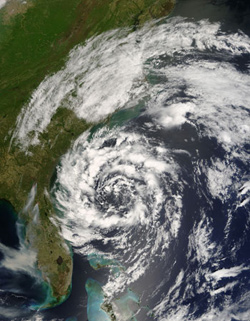Hurricane forecast calls for 7 hurricanes, 3 major, in 2008
Hurricane forecast calls for 7 hurricanes, 3 major, in 2008
mongabay.com
December 7, 2007
2008 forecast: 13 named storms, 7 hurricanes, 3 major hurricanes, 1 U.S. strike probable
Hurricane forecasters William Gray and Philip Klotzbach are predicting a “somewhat above-average” hurricane season for 2008. The Colorado State University researchers anticipate seven Atlantic hurricanes, three of them “major” (category 3 or higher), during the 2008 season. In total 13 named storms in the Atlantic are expected.
Gray and Klotzbach estimate a 60 percent probability that a major hurricane will hit the U.S. coastline. The eastern seaboard faces slightly higher risk than the Gulf coast region.
“Despite fairly inactive 2006 and 2007 hurricane seasons, we believe that the Atlantic basin is still in an active hurricane cycle,” Gray told the Associated Press. “This active cycle is expected to continue at least for another decade or two.”
 The swirling clouds of an intense low-pressure system sat off the southeast coast of the U.S. on Tues., May 8, when the Moderate Resolution Imaging Spectroradiometer (MODIS) on NASA’s Terra satellite captured this image. By the following morning, the system had developed into a subtropical storm. While Andrea has the circular shape of a tropical cyclone, it lacks the tight organization seen in more powerful storms. Winds associated with Andrea have worsened wildfires (red boxes) in Georgia and Florida. Image credit: NASA Goddard Space Flight Center. Caption credit: Mike Bettwy, RSIS/NASA Goddard Space Flight Center. |
The authors say it is this cyclical process rather than global warming that is responsible for about average hurricane activity in recent years.
“The global warming arguments have been given much attention by many media references to recent papers claiming to show such a linkage. Despite the global warming of the sea surface that has taken place over the last 3 decades, the global numbers of hurricanes and their intensity have not shown increases in recent years except for the Atlantic,” write Gray and Klotzbach.
“The Atlantic has seen a very large increase in major hurricanes during the 13-year period of 1995-2007 (average 3.8 per year) in comparison to the prior 25-year period of 1970-1994 (average 1.5 per year). This large increase in Atlantic major hurricanes is primarily a result of the multi-decadal increase in the Atlantic Ocean thermohaline circulation (THC) that is not directly related to global temperature increase. Changes in ocean salinity are believed to be the driving mechanism. These multi-decadal changes have also been termed the Atlantic Multidecadal Oscillation (AMO).”
Evidence of global warming?
|
“There have been similar past periods (1940s-1950s) when the Atlantic was just as active as in recent years. For instance, when we compare Atlantic basin hurricane numbers over the 15-year period from 1990-2004 with an earlier 15-year period (1950-1964), we see no difference in hurricane frequency or intensity even though the global surface temperatures were cooler and there was a general global cooling during 1950-1964 as compared with global warming during 1990-2004.”
Last year the hurricane prediction team called for nine Atlantic hurricanes but only six formed. In 2005, Gray and Klotzbach again expected nine hurricanes, but five materialized. Still the team’s predictions are closely monitored by disaster planners and agencies.
2007 saw only two major hurricanes form in the Atlantic (Felix and Dean), but had the distinction of being the first year to have two Category 5 storms make landfall in a single hurricane season.
Related
Historical records of Atlantic hurricanes are accurate says study
(11/28/2007) Counting tropical storms that occurred before the advent of aircraft and satellites relies on ships logs and hurricane landfalls, making many believe that the numbers of historic tropical storms in the Atlantic are seriously undercounted. However, a statistical model based on the climate factors that influence Atlantic tropical storm activity shows that the estimates currently used are only slightly below modeled numbers and indicate that the numbers of tropical storms in the recent past are increasing, according to researchers.
Wind shear could reduce future hurricane activity
(4/17/2007) The debate over the impact of global warming on hurricane intensity rages on with a new study published April 18 in Geophysical Research Letters. The research, conducted by Gabriel A. Vecchi of the National Oceanic and Atmospheric Administration (NOAA) and Brian J. Soden of the University of Miami, suggests that an increase in vertical wind shear in the tropical Atlantic and East Pacific Oceans could inhibit the formation and intensification of hurricanes. The authors note that increased vertical wind shear has historically been associated with reduced hurricane activity and intensity.